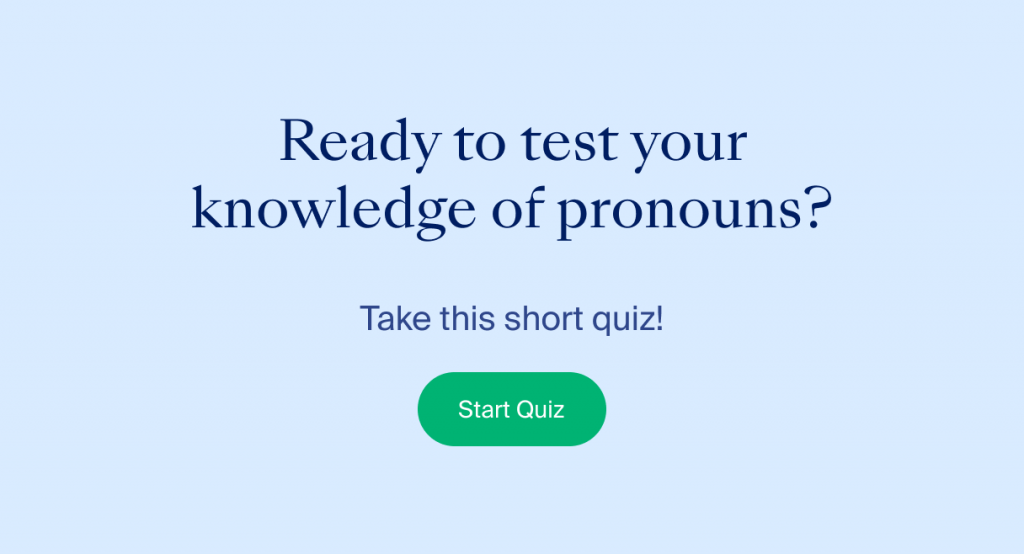Pronouns are words that take the place of a noun or a noun phrase to make sentences easier to read. Take the following sentence, for example:
Because she knew that Jack loves pugs, his mom got him one for his birthday.
Without the pronouns, it would read:
Because Jack’s mom knew that Jack loves pugs, Jack’s mom got Jack a pug for Jack’s birthday.
Doesn’t that make you appreciate pronouns? The English language includes over 100 different pronouns, but in today’s post, we’ll focus on the ones you’ll probably use the most in your writing.
Personal Pronouns
Personal pronouns are usually used in place of a person’s name or a group of people. If the person is the one performing the action, we use one of these subject pronouns: I, you, he, she, we, they, or it.
I like ice cream.
Do you want some ice cream?
He / she hates ice cream.
Shall we buy an ice cream?
Do they have chocolate flavor?
It is Charlie’s favorite.
On the other hand, if the pronoun replaces the name of the one(s) having the action done to them, we use an object pronoun: me, you, him, her, us, them, or it.
Ice cream gives me a toothache.
Ice cream will refresh you.
Is there some for him / her?
There’s plenty for us to share with them.
Charlie dropped it on the floor.
The noun that a pronoun stands in for is known as its antecedent. Often, the antecedent will already have appeared earlier in the sentence:
Charlie dropped his ice cream, and he began to wail.
In this example, “Charlie” is the antecedent for the pronoun “he.” Note that even though “he” replaces the proper noun “Charlie,” it doesn’t require a capital letter. Personal pronouns aren’t usually capitalized unless they’re used to begin a sentence. The only exception to this rule is the pronoun “I,” which always uses a capital letter.
It’s important to use a pronoun that matches its antecedent in both number (i.e., singular or plural) and gender. The third person pronoun “they” is traditionally used as a plural (for a group of people or things) or as a singular when the gender of the antecedent is unknown:
Somebody stole my ice cream; they will be sorry!
“They” is also now widely accepted as a singular pronoun for people of neutral gender.
Possessive Pronouns
English has six independent possessive pronouns. These replace a noun phrase while indicating ownership. In the following examples, we’ve shown the substituted noun phrase in parentheses:
Shall we go to your place or mine (my place)?
The handwriting was his (his handwriting).
The sunglasses are hers (her sunglasses).
The house at the end is ours (our house).
Is this cup yours (your cup)?
Find this useful?
Subscribe to our newsletter and get writing tips from our editors straight to your inbox.
We ate our ice cream, not theirs (their ice cream).
The other kind of possessive pronoun is the possessive determiner. The seven possessive determiners function as adjectives, so they’re always followed by a noun:
My place is untidy.
His handwriting is elegant.
Her sunglasses are stylish.
The dog chased its tail.
It will take five minutes to walk to our house.
Your cup is empty.
Their ice cream has vanished.
Note that even though possessive pronouns indicate ownership, they don’t have an apostrophe. This often confuses people, especially in the case of “its.” Remember, an apostrophe is only needed in “it’s” when you’re using it as a contraction of “it is” or “it has.”
Demonstrative Pronouns
Demonstrative pronouns indicate specific people, items, or groups thereof. The context of the sentence should make it clear to the reader what the demonstrative pronoun refers to. The most common ones are this, these, that, and those:
● This is used for singular items that are physically or figuratively close by:
This is a scary movie.
● These is for a group of things that are close by:
These are delicious cakes.
● That refers to a singular item at a distance (literally or metaphorically):
She’s lucky to be a movie star. That is my dream job.
● Those refers to more than one thing at a distance:
Those are cows, not rabbits.
Indefinite Pronouns
Indefinite pronouns refer to an unspecified person or thing. Therefore, they don’t have an antecedent.
Somebody knows what happened.
Is anyone there?
I didn’t see any.
Have you had enough?
When the subject of a sentence or clause is an indefinite pronoun (as it is in our first two examples), you would usually use the singular verb form. But there are a number of exceptions to this rule; both, few, many, most, others, several, and some would all be followed by verbs with the plural form.
I invited 50 people, but several aren’t coming.
Summary: How to Use Pronouns Correctly
As we have seen, pronouns are useful for reducing repetition and making your writing easier to understand. Here are some important things to keep in mind when using pronouns:
● All pronouns should agree with their antecedent in terms of number and gender.
● With the exception of “I,” personal pronouns don’t need to be capitalized unless they’re used to begin a sentence.
● “They” is traditionally a plural pronoun, but it can also be used in the singular form when you’re referring to someone of unknown or neutral gender.
● Possessive pronouns don’t have an apostrophe.
● Indefinite pronouns (e.g., somebody, anyone) usually accompany a verb in the singular form. But both, few, many, most, others, several, and some go with plural verbs.

We hope you now feel more confident about using pronouns in your writing. And if you want to be certain that your writing is free of grammatical errors, our proofreaders can help. Try us out for free by submitting a trial document today.


